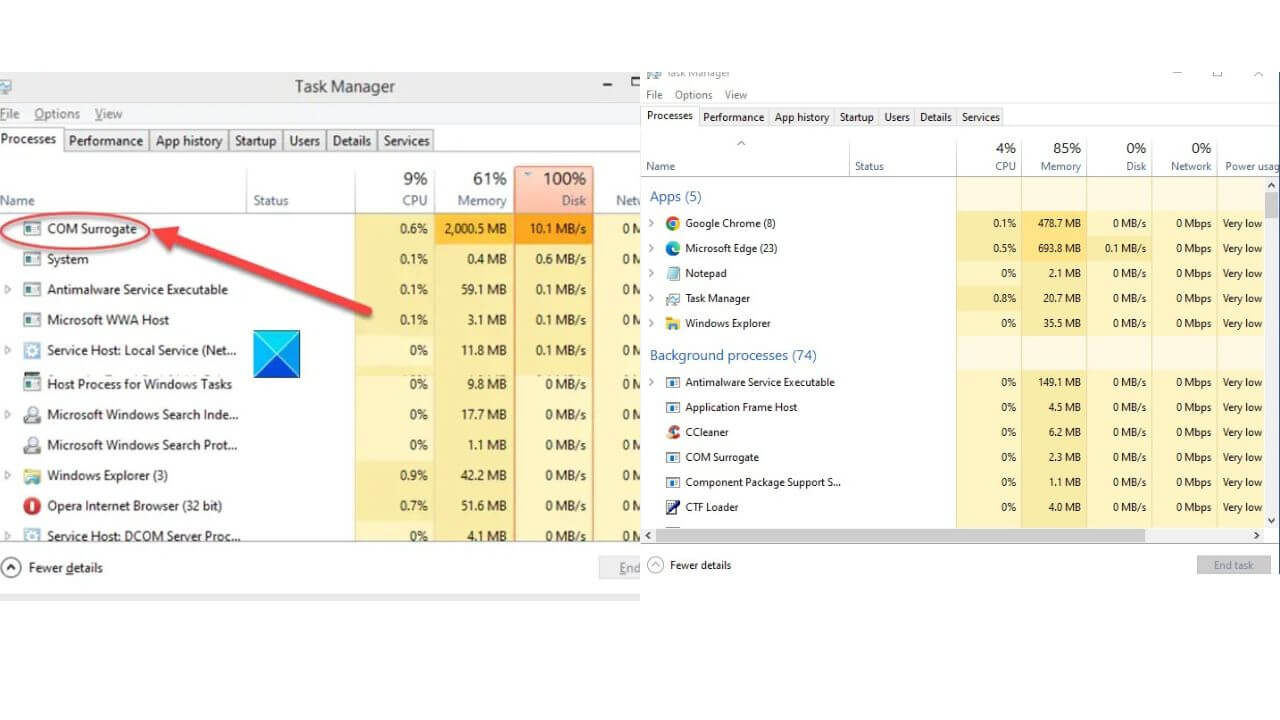In today’s digital age, computers play an integral role in our lives, whether for work, entertainment, or communication. However, like any complex system, they can encounter issues from time to time.
One such issue that Windows users may encounter is COM Surrogate high CPU usage. This problem can be frustrating, as it can slow down your computer and disrupt your workflow.
In this comprehensive guide, we will delve into the causes of this issue and provide you with effective solutions to resolve it.
Understanding COM Surrogate
Before we delve into the solutions, let’s take a moment to understand what a COM surrogate is. COM Surrogate, short for Component Object Model Surrogate, is a crucial Windows process that allows applications to run code in separate, isolated processes.
This separation helps enhance system stability and security. However, when COM Surrogate starts consuming excessive CPU resources, it can lead to system slowdowns and performance issues.
Common Causes of COM Surrogate High CPU Usage
1. Thumbnail Generation
One of the primary reasons for COM Surrogate high CPU usage is thumbnail generation. When you open a folder containing image or video files, Windows generates thumbnails to provide you with a preview of the files. Sometimes, this process can become resource-intensive, causing COM Surrogate to consume excessive CPU power.
2. Incompatible Codecs
Another common cause is the presence of incompatible codecs. Codecs are software components that encode and decode multimedia files. If you have incompatible or outdated codecs installed on your system, COM Surrogate may struggle to handle multimedia files efficiently, resulting in high CPU usage.
3. Malware or Virus Infections
Malware or virus infections can also trigger COM Surrogate high CPU usage. Malicious software can interfere with system processes, causing them to consume more resources than usual. Regularly scanning your computer for malware is essential to prevent such issues.
Resolving COM Surrogate High CPU Usage
Now that we’ve identified the potential causes, let’s explore the solutions to resolve COM Surrogate high CPU usage.
1. Disable Thumbnail Generation
To address the issue related to thumbnail generation, you can disable the automatic creation of thumbnails in Windows.
Windows generates thumbnail previews for files in certain folders, which can sometimes trigger COM Surrogate issues. To disable this feature:
- Press
Win + Eto open File Explorer. - Click
Viewand then selectOptions > Change folder and search options.
In the Folder Options window:
- Navigate to the
Viewtab. - Check the box that says
Always show icons, never thumbnails. - Click
Applyand thenOKto save the changes.
2. Update or Remove Incompatible Codecs
If you suspect incompatible codecs are causing the problem, consider updating or removing them. Ensure you have the latest codec packs installed and remove any conflicting codecs.
Outdated or incompatible codecs are a common cause of COM Surrogate high CPU usage. To update codecs:
- Press
Win + Sand search forOpenit. - Click
Programsand then selectTurn Windows features on or off. - Uncheck the box next to
Media Featuresand clickOK.
3. Scan for Malware and Viruses
Perform a full system scan using a reputable antivirus program to detect and remove any malware or viruses that may be causing high CPU usage.
4. Update Your Graphics Drivers
Outdated or corrupt graphics drivers can also contribute to COM Surrogate high CPU usage. Visit the official website of your graphics card manufacturer to download and install the latest drivers.
5. System File Checker (SFC) Scan
Running an SFC scan can help identify and repair corrupted system files that may be contributing to the issue.
Open Command Prompt as Administrator.Type 'sfc /scannow' and press Enter.Wait for the scan to complete.Follow on-screen instructions if prompted.Restart your computer.
6. Perform a Clean Boot
Third-party software conflicts can also trigger COM Surrogate issues. To perform a clean boot:
- Press
Win + Rand typemsconfig.PressEnter.
In the System Configuration window:
- Navigate to the
Servicestab. - Check the box that says
Hide all Microsoft services. - Click
Disable all.
In the same window:
- Go to the
Startuptab. - Click
Open Task Manager. - Disable all startup items one by one.
Finally, restart your computer to apply the changes.
Conclusion
COM Surrogate high CPU usage can be a frustrating problem, but with the right solutions, you can resolve it and restore your computer’s performance. By following the steps outlined in this guide, you’ll be able to tackle this issue efficiently and get back to using your Windows system smoothly. Remember to stay vigilant against malware and keep your system and drivers up to date to prevent future occurrences of this problem.
#COMSurrogate #CPUUsage #HighCPUUsage #Troubleshooting #Windows #ComputerPerformance #SystemOptimization #TechHelp #PCProblems #FixItNow #TaskManager










Very informative and fantastic bodily structure of content, now that’s user friendly (:.
9c136k
I just couldn’t depart your website before suggesting that I actually enjoyed the standard info an individual supply for your guests? Is going to be back continuously in order to check up on new posts
When I originally commented I clicked the -Notify me when new comments are added- checkbox and now every time a remark is added I get four emails with the same comment. Is there any approach you can take away me from that service? Thanks!